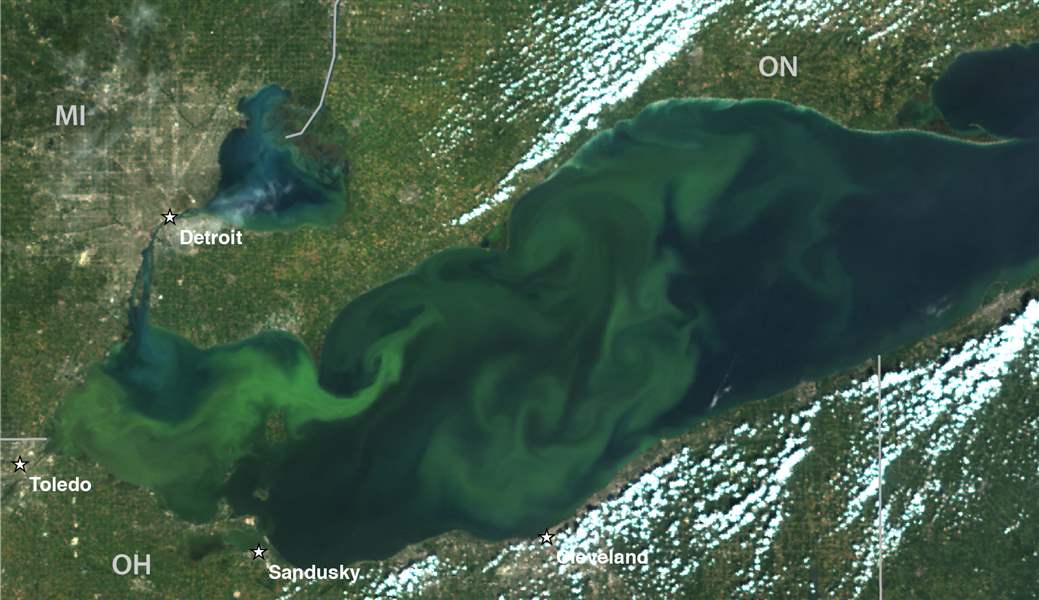
New BGSU center will study fresh water, human health
10/29/2018
Image of an algal bloom in Lake Erie.
NOAA
BOWLING GREEN — Bowling Green State University announced plans Monday for a new research center which aims to greatly expand how scientists investigate harmful algal blooms that cost Americans at least $2 billion a year in costs ranging from lost recreation to more expensive water treatment.
The Lake Erie Center for Fresh Waters and Human Health is one of only three projects nationally that will receive millions of dollars in funding under a special joint, five-year program created by the National Science Foundation and the National Institute of Environmental Health Sciences for major water quality studies.
The new BGSU center also is the only one of those three designed to focus on freshwater.
BGSU President Rodney Rogers at a news conference Monday said the university’s selection for the grant money “is a strong show of support in the quality of research into harmful algal blooms.”
George Bullerjahn, one of BGSU’s best known algae researchers, has been named the center’s director and principal investigator. He said the center should eventually help with predicting both the onset and toxicity of Lake Erie algal blooms each summer, fueled in large part by climate change, wetlands destruction, and agricultural runoff.
“Yes, climate change is real,” Mr. Bullerjahn said. “We're seeing different kinds of cyanobacteria,” he added, explaining that another goal of the expanded research is to learn more about how certain types of harmful, blue-green algae — which scientists call cyanobacteria — become dominant.
The BGSU center will not be a freestanding building, but will occupy the fifth floor of the university Life Sciences building. Much of its costs will go toward larger and more sophisticated databases to store sampling results, Mr. Bullerjahn told The Blade after the news conference.
Initial funding consists of a five-year, $5.2 million grant issued by the NSF and NIEHS. NSF and NIEHS also have pledged another $30 million for the three national recipients to expand their work.
U.S. Rep. Marcy Kaptur (D., Toledo), Ohio Sen. Randy Gardner (R. Bowling Green), and Bowling Green Mayor Dick Edwards were among those attending the news conference.
Miss Kaptur said the grant puts BGSU and other area universities even more at the “cutting edge of 21st century research” for freshwater.
She also cited the human health component, saying that although Toledo-area tap water is safe to drink in the short term, there continues to be questions raised about long-term exposure to low-level algal toxins and chemicals used by area water-treatment plants to remove them.
“We do worry about some long-term impacts,” Miss Kaptur said.
She agreed climate change is a wild card, saying that “one of the most vexing problems is added rainfall.”
“Our environment is telling us something about ourselves,” Miss Kaptur said.
Mr. Gardner called clean drinking water one of the few things both parties cite as a priority.
“This almost exclusively has become a bipartisan issue,” Mr. Gardner said, citing general agreement on the issue by state and federal legislators from both parties.
Other researchers to be involved with BGSU’s new center include University of Toledo Lake Erie Center Director Tom Bridgeman, University of Tennessee researcher Steven Wilhelm, University of Michigan researcher Greg Dick, Ohio State University researcher Justin Chaffin, and University of North Carolina researcher Hans Paerl.
The grant provides about $10,000 a year to help those and other researchers afford the costs of more field work, mostly from additional boat trips run out of UT’s Lake Erie Center near Maumee Bay State Park and OSU-Ohio Sea Grant’s Stone Laboratory on Lake Erie’s Gibraltar Island.
“We're even getting a couple of cots, so they can sleep over in our lounge if they want,” Mr. Bridgeman told The Blade.
The center will be a collaboration between BGSU and nine other universities and research institutions, including the University of Toledo, the University of Michigan, and Ohio State University. Other partners include Ohio Sea Grant, the National Oceanic and Atmospheric Administration, Michigan State University, the State University of New York, the University of Tennessee, and the University of North Carolina.
BGSU has been one of the region’s leaders in studying algal blooms from a global perspective.
The university won a major federal grant after the 2014 Toledo water crisis to host a two-day, first-of-its-kind forum on campus that brought in algae researchers from Asia, Africa, Europe, and other parts of the world. Presentations from that 2015 seminar showed common denominators: Climate change and poor land use, with consistently higher agricultural runoff in most affected parts of the world.
BGSU’s three best-known algae researchers — Mr. Bullerjahn, Tim Davis and Mike McKay — went to Africa’s Lake Victoria last spring to study algal blooms there.
Each is familiar with other major hotspots, such as China’s Lake Taihu, the Florida Everglades, the Pacific Northwest, and many parts of Canada.
Mr. Davis said the $2 billion cost estimate of algae’s impact on Americans is so far outdated now it is almost meaningless. It was made in 2009, long before the crises in Toledo, South Florida, and one this summer in Salem, Ore., as well as other parts of the country.
“This project has the ability to advance not just the science of harmful algal blooms, but also the socioeconomic impacts,” he said.